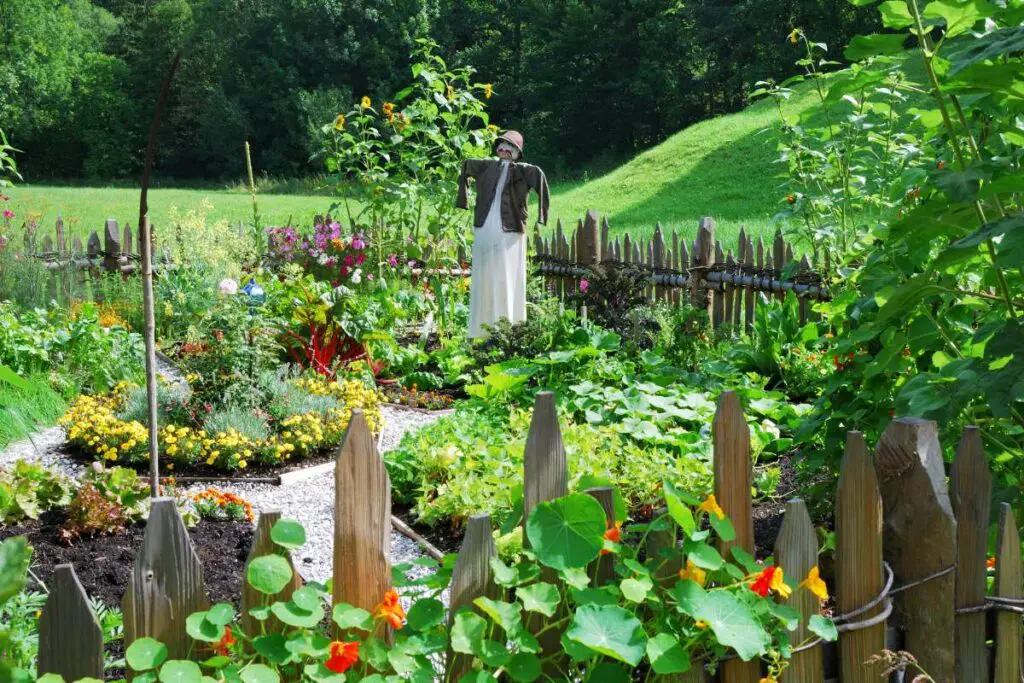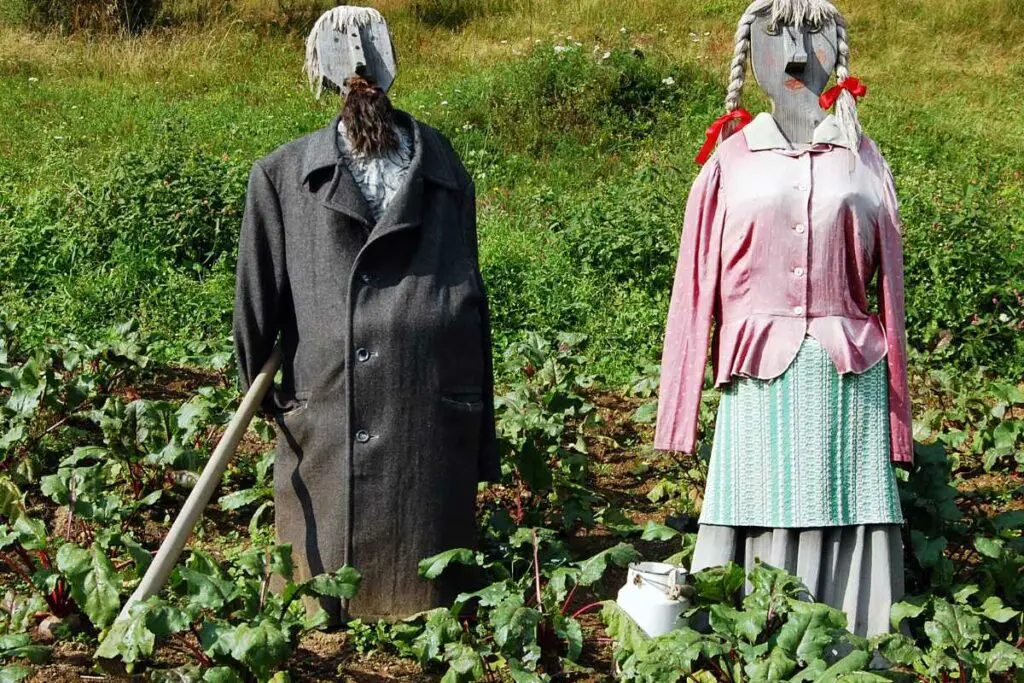
If you’ve ever had a backyard garden, you know how frustrating it can be to watch birds and other animals feast on your hard-earned fruits and vegetables.
One potential solution that has been used for centuries is the scarecrow.
But do scarecrows actually work in backyard gardens?
Scarecrows can be effective in deterring birds and other animals from your garden. However, their effectiveness can vary depending on a few factors. For example, if you have a small garden, a single scarecrow may be enough to do the trick. But if you have a larger garden, you may need to use multiple scarecrows or other methods in addition to the scarecrow to fully protect your crops.
The Purpose of Scarecrows
Scarecrows have been used for centuries to protect crops from birds, and they continue to be a popular method of bird control in gardens today.
The purpose of a scarecrow is to scare birds away from the crops while still allowing them in other parts of the yard to eat insects and grubs.
Do Scarecrows Work?
The effectiveness of scarecrows in the garden is a topic of debate among gardeners. While some gardeners swear by them, others claim that they are not effective at all.
The truth is that scarecrows can be effective in keeping birds away from your crops, but they are not a foolproof method of bird control.
Scarecrows work best when used in combination with other bird control methods, such as bird netting or reflective tape.
Variety is the key to keeping birds away with scarecrows. By changing the position and appearance of your scarecrow regularly, you can keep birds on their toes and prevent them from becoming accustomed to it.
Types of Scarecrows
There are many different types of scarecrows available on the market today, from traditional straw scarecrows to modern, high-tech versions that use motion sensors and sound to scare birds away. Some popular types of scarecrows include:
- Traditional straw scarecrows
- Plastic owl or hawk decoys
- Birds of prey kites
- Reflective tape or streamers
- Motion-activated sprinklers
When choosing a scarecrow for your garden, it is important to consider the type of birds that are causing the most damage to your crops.
Different birds are scared by different things, so it may take some trial and error to find the right type of scarecrow for your garden.
Choosing the Right Scarecrow
Scarecrows can be an effective way to keep birds and other pests out of your garden. However, choosing the right scarecrow is important to ensure that it is effective.
Here are some things to consider when choosing the right scarecrow for your garden.

Making a scarecrow can be fun
One option is to make your own scarecrow. Making a scarecrow can be a fun and creative activity for the whole family.
You can use materials you have on hand such as old clothes, hats, and gloves. You can also use straw or hay to stuff the scarecrow.
Making your own scarecrow allows you to customize the size, height, and design to fit your garden.
Size and Height
The size and height of your scarecrow is important. You want to make sure that it is tall enough to be seen by birds and other pests.
A scarecrow that is too short may not be effective. A good rule of thumb is to make your scarecrow at least as tall as you are.
This will ensure that it is visible to birds and other pests.
Material and Design
The material and design of your scarecrow is also important. You want to make sure that it is sturdy enough to withstand the elements.
A scarecrow made from flimsy materials may not last long. You also want to make sure that the design of your scarecrow is scary enough to keep birds and other pests away.
Some scarecrows have scary faces or are made to look like predators such as owls or hawks. These types of scarecrows can be effective in keeping birds and other pests away.
When choosing a scarecrow, consider the type of birds and pests that are causing problems in your garden.
Some scarecrows may be more effective at scaring off certain types of birds or pests. For example, some scarecrows are designed specifically to scare off crows.
Others may be more effective at scaring off smaller birds such as sparrows or finches.
Using Scarecrows in Your Garden
Placement
When it comes to using scarecrows in your garden, placement is key. You want to make sure that the scarecrow is visible to birds and other animals that you want to deter from your garden.
Place your scarecrow in an open area where it can be easily seen. You can also place it on a pole or stake to make it more visible.
It’s important to note that scarecrows are not one-size-fits-all. You may need multiple scarecrows in different areas of your garden to effectively scare away birds and animals.
For example, if you have a large garden, you may need multiple scarecrows spaced out throughout the area.
Maintenance
Scarecrows require some maintenance to be effective. You want to make sure that they remain visible and scary to birds and animals.
This means regularly checking your scarecrow to make sure it is still standing and in good condition. If your scarecrow is damaged or knocked over, it may no longer be effective at scaring away animals.
You can also change the appearance of your scarecrow to keep it effective. For example, you can change the clothing or add reflective materials to make it more visible.
You can also move the scarecrow around your garden to keep birds and animals guessing.
Overall, scarecrows can be an effective way to protect your flowers and other plants from birds and animals.
By placing them in the right areas and maintaining them properly, you can keep your garden safe and thriving.
Do scarecrows work on Crows?
Scarecrows can be effective in deterring many bird species, including crows, pigeons, sparrows, and blackbirds.
However, there are some species of birds that may not be intimidated by scarecrows and may continue to feed on crops even in the presence of a scarecrow.
For example, birds of prey such as hawks and eagles are less likely to be deterred by a scarecrow since they are predators and are not as easily frightened by a stationary object.
Similarly, water birds such as ducks and geese may not be deterred by scarecrows since they are accustomed to human presence and may not see the scarecrow as a threat.
In general, the effectiveness of a scarecrow in deterring birds depends on several factors, including the type of bird, the location of the scarecrow, and the quality of the scarecrow itself.
Some birds may be more persistent in their feeding habits and may require additional measures to protect crops, such as netting or bird repellent.
Final Thoughts about Using a Scarecrow in Your Backyard
Overall, using a scarecrow in your backyard can be an effective way to keep birds and other animals away from your garden. However, it’s important to consider the pros and cons before making a decision.
One of the main benefits of using a scarecrow is that it’s a natural and humane way to deter pests. Unlike chemical sprays or traps, scarecrows don’t harm the animals in any way. They simply scare them away from your garden.
On the other hand, scarecrows can be a bit of an eyesore in your backyard. They can also be ineffective in the long run, as birds and other animals may eventually get used to them and ignore them.
If you do decide to use a scarecrow, it’s important to choose the right type and set it up correctly. Make sure the scarecrow is positioned in a visible area and moved around occasionally to make it seem more realistic.
You can also consider using other decoys or deterrents in addition to the scarecrow.
Ultimately, whether or not to use a scarecrow in your backyard is a personal decision. Consider the pros and cons, and decide what’s best for your garden and your own preferences.


